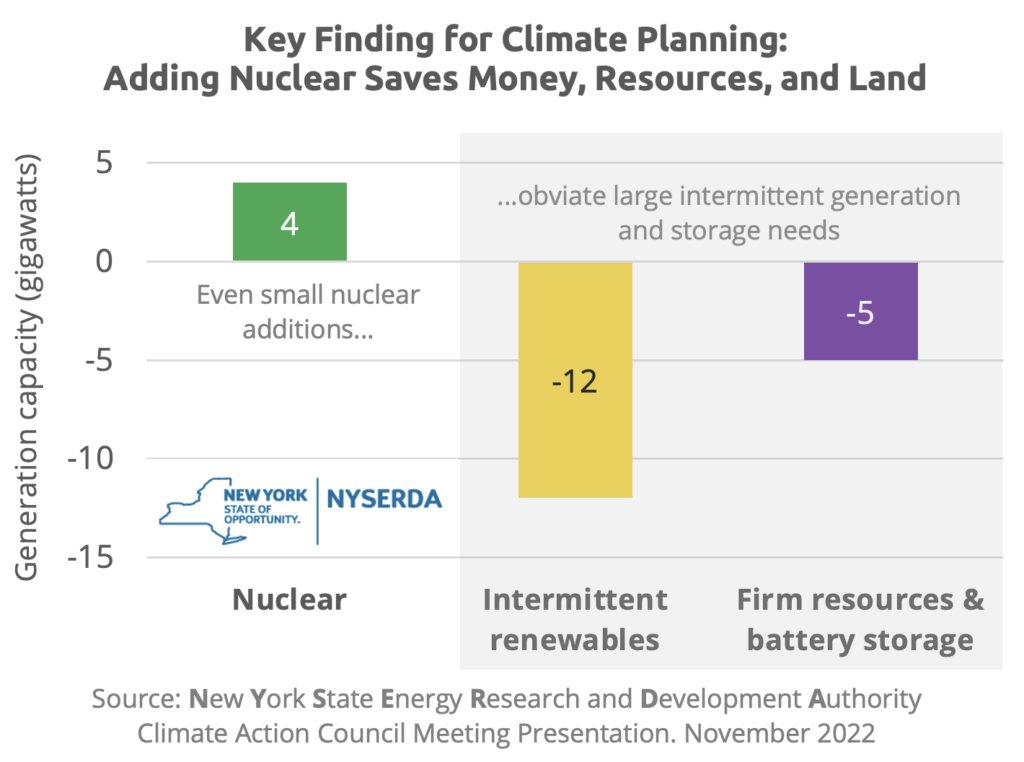FOR IMMEDIATE RELEASE: November 14, 2022

Albany, NY – Today climate scientists, engineers, environmentalists, labor and community leaders applaud the New York State Energy Research and Development Authority (NYSERDA) for recognizing the importance of nuclear power in meeting state energy goals—now and in the future.
“It’s a significant step in the right direction,” said Dr. James E. Hansen, renowned climate scientist at the Columbia Earth Institute and former director of NASA’s Goddard Institute. “By committing to zero-emission nuclear power, New York can help lead the nation and world to a brighter future.”
In April, Hansen testified before policymakers on draft plans for implementing the Climate Leadership and Community Protection Act, a state law mandating dramatic cuts in greenhouse gas emissions and carbon-free electricity by 2040. Calling for a realistic approach to decarbonization while strengthening the economy, he and labor leaders cautioned New York not to follow in the footsteps of Germany, where opposition to nuclear power has undermined climate action, damaged grid reliability, and threatened energy security.
“We need all tools in the toolbox to power a clean and reliable energy system,” said John Murphy of Clean Energy Jobs Coalition, which represents over 270,000 union workers across New York State. “Nuclear power means technology and middle-class sustaining jobs that are Made-In-America, so our members are pleased to see NYSERDA considering the possibilities.”
On November 7th, NYSERDA presented information to the state’s Climate Action Council about nuclear technology, including the multi-billion-dollar savings achieved by extending the life of New York’s operational reactors, the value of advanced nuclear to decarbonize the state’s grid, and the potential to generate clean hydrogen and industrial heat to decarbonize other sectors. In fact, NYSERDA and the U.S. Department of Energy are already funding a demonstration project at Nine Mile Point that will become the nation’s first nuclear-powered clean hydrogen production facility. At the Council meeting, NYSERDA also highlighted action in deploying nuclear across the country using Small Modular Reactors—in Idaho, Tennessee, Wyoming, and Washington. Provisions of the Inflation Reduction Act and other prospects for federal support of nuclear energy were also discussed.
“Throughout the United States and the world, advanced industrial democracies are waking up to the vitality of this remarkable technology to seriously tackle climate change and reduce air pollution while meeting the growing needs of society,” said Valerie Gardner of Climate Coalition. “We hope that New York takes advantage of this opportunity to lead.”
NYSERDA’s preliminary projections suggest that the state could build four gigawatts of new nuclear capacity. In addition to avoiding 30 million tons of greenhouse gas emissions from fossil fuels every year, doing so would help protect New York’s farmland and nature.
“Nuclear would be a blessing,” said Dennis Higgins, a sustainable farmer from upstate New York. “With its tiny footprint and ability to run 24/7, four gigawatts of new nuclear would bring solid jobs upstate, save over 100,000 acres of rural New York from energy sprawl, and reliably power my heat pump in the winter.”
An extensive lifecycle analysis by the United Nations confirms that nuclear power is the least impactful of all energy sources with respect to land use, mining, materials, and toxicity. It is also among the safest, along with solar and wind. Importantly, by expanding the role of nuclear within its clean energy portfolio, New York can make good on its promise of environmental justice.
“As an immigrant from Sri Lanka, I have witnessed first-hand the consequences of scarce, unreliable energy,” said Isuru Seneviratne, energy analyst at Radiant Value Management. “And as a resident of Queens, I understand the air pollution impacts on Asthma Alley. With nuclear power in the picture, New Yorkers won’t have to choose between dirty air or having electricity only when the weather cooperates.”
“Nuclear is becoming a key focus for Environmental-Social-Governance (ESG) investors as governments, corporations and clean energy advocates continue to highlight the industry’s excellent ESG credentials,” said Arthur Hyde, Portfolio Manager of New York-based Segra Capital Management, the largest dedicated nuclear-focused investor. “2022 has been a banner year with the inclusion of nuclear in the EU Taxonomy for sustainable activities and Canada’s inaugural issuance of Nuclear Power Green Bonds, which was six-times oversubscribed.”
Hyde’s comments on ESG investment dovetail with those on research made during the Climate Action Council’s meeting in November: “I am really in favor of looking at nuclear,” said council member Dennis Elsenbeck. “We need to think about this sooner than later because there is going to be research dollars available, and I’d like to see our universities capture those.”
Carl Perez, CEO of Exodys Energy, a New York-based nuclear engineering firm developing solutions to recycle spent fuel into centuries of clean energy, added: “We applaud NYSERDA’s proposal to include advanced nuclear in the state’s energy mix. New York’s ecosystem of innovation can thrive by leveraging and revitalizing existing R&D, manufacturing, and nuclear infrastructure.”
As recently confirmed by the $120 billion plus commitment by Micron and IBM to build new, world-class chip manufacturing facilities in New York, demand for both clean reliable power and thousands of good paying jobs are on the horizon. This reaffirms the urgency for New York to unleash its spirit of innovation, activate expertise, and leverage its financial sophistication to reap the rewards of carbon-free nuclear power.
As U.S. Special Climate Envoy John Kerry recently stated at the UN Climate Conference COP27, “We don’t get to net zero by 2050 without nuclear power in the mix.”
“We urge the Climate Action Council to accept NYSERDA’s recommendations for existing and advanced nuclear energy in its climate plan,” concluded Hansen. With the right technological choices and policies, New York can deploy our most scalable tool to combat climate change while ensuring reliable energy vital to human prosperity. NYSERDA’s support for nuclear power brings New York closer to realizing a Bright Future.
The Council is scheduled to finalize its plan in December 2022.
